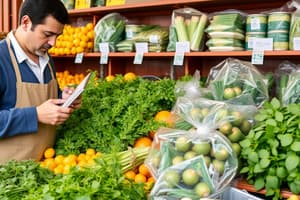Podcast
Questions and Answers
A machine design engineer is designing a standard shaft for an agricultural machine. Which steel designation is typically used for this application?
A machine design engineer is designing a standard shaft for an agricultural machine. Which steel designation is typically used for this application?
- Steel designation 304
- Any readily available steel
- Steel designation 1020 (cold rolled) (correct)
- Steel designation 316
When calculating the power rating for a stainless steel shaft, what adjustment must be made compared to a standard keyseated shaft?
When calculating the power rating for a stainless steel shaft, what adjustment must be made compared to a standard keyseated shaft?
- Use 1/5 of the nominal ultimate tensile strength instead of 1/10.
- Multiply by the appropriate safe shear stress factor from Table 1. (correct)
- Increase the safe shear stress by a factor of 10.
- No adjustment is needed.
What is the primary function of shafts in agricultural machinery?
What is the primary function of shafts in agricultural machinery?
- To transmit power or motion and control the geometry of movement. (correct)
- To provide structural support for the machinery's frame.
- To act as a protective covering for sensitive components.
- To store potential energy for later use.
For a material with a nominal ultimate tensile strength of 600 MPa, what safe shear stress should be used for shaft design if specific table values are unavailable?
For a material with a nominal ultimate tensile strength of 600 MPa, what safe shear stress should be used for shaft design if specific table values are unavailable?
Under what circumstances would a machine design engineer most likely choose a stainless steel (304 or 316) over a standard 1020 steel for constructing a shaft?
Under what circumstances would a machine design engineer most likely choose a stainless steel (304 or 316) over a standard 1020 steel for constructing a shaft?
Using Table 1, estimate the safe shear stress factor when the safe shear stress is approximately 51.71 MPa.
Using Table 1, estimate the safe shear stress factor when the safe shear stress is approximately 51.71 MPa.
According to the data in Table 1, how does the safe shear stress factor change as the safe shear stress increases?
According to the data in Table 1, how does the safe shear stress factor change as the safe shear stress increases?
A material is subject to a safe shear stress of 22 MPa. Using the provided data, what is the approximate safe shear stress factor?
A material is subject to a safe shear stress of 22 MPa. Using the provided data, what is the approximate safe shear stress factor?
A mechanical engineer needs a safe shear stress factor of approximately 0.80. Based on Table 1, what safe shear stress value should they target?
A mechanical engineer needs a safe shear stress factor of approximately 0.80. Based on Table 1, what safe shear stress value should they target?
If a material has a safe shear stress of 100 MPa, what would you estimate the corresponding safe shear stress factor to be, based on the values provided?
If a material has a safe shear stress of 100 MPa, what would you estimate the corresponding safe shear stress factor to be, based on the values provided?
Which organization initiated the formulation of the Philippine Agricultural Engineering Standard (PAES) 305:2000?
Which organization initiated the formulation of the Philippine Agricultural Engineering Standard (PAES) 305:2000?
What is the primary focus of the Philippine Agricultural Engineering Standard (PAES) 305:2000 regarding shafts for agricultural machines?
What is the primary focus of the Philippine Agricultural Engineering Standard (PAES) 305:2000 regarding shafts for agricultural machines?
Which of the following topics is explicitly excluded from the scope of the Philippine Agricultural Engineering Standard (PAES) 305:2000?
Which of the following topics is explicitly excluded from the scope of the Philippine Agricultural Engineering Standard (PAES) 305:2000?
Which of the sources listed would provide comprehensive information regarding mechanical engineering principles relevant to shaft design for agricultural machinery, according to the references used to prepare PAES 305:2000?
Which of the sources listed would provide comprehensive information regarding mechanical engineering principles relevant to shaft design for agricultural machinery, according to the references used to prepare PAES 305:2000?
In the context of developing PAES 305:2000, what was the role of the Philippine Society of Agricultural Engineers (PSAE)?
In the context of developing PAES 305:2000, what was the role of the Philippine Society of Agricultural Engineers (PSAE)?
What is the significance of PNS 01:Part 4:1998 in the context of PAES 305:2000?
What is the significance of PNS 01:Part 4:1998 in the context of PAES 305:2000?
A design engineer is selecting a shaft for a high-torque application in an agricultural tractor. Considering the information provided, which resource would be MOST relevant for determining appropriate shaft specifications?
A design engineer is selecting a shaft for a high-torque application in an agricultural tractor. Considering the information provided, which resource would be MOST relevant for determining appropriate shaft specifications?
What was the primary role of the National Agriculture and Fisheries Council (NAFC) during the finalization of the standards?
What was the primary role of the National Agriculture and Fisheries Council (NAFC) during the finalization of the standards?
Flashcards
Shafts
Shafts
Rotating machine members with circular cross sections used to transmit power or motion, providing the axis of rotation for components.
Standard Shaft Material
Standard Shaft Material
Steel designated as 1020, formed through cold rolling, commonly used for standard shafts in agricultural machinery.
Stainless Steel Shafts
Stainless Steel Shafts
Stainless steel, typically designated as 304 or 316, selected for specialized applications needing enhanced corrosion resistance.
Power Rating
Power Rating
Signup and view all the flashcards
Safe Shear Stress
Safe Shear Stress
Signup and view all the flashcards
Safe Shear Stress Factor
Safe Shear Stress Factor
Signup and view all the flashcards
Factor at 3.447 MPa
Factor at 3.447 MPa
Signup and view all the flashcards
Factor at 41.369 MPa
Factor at 41.369 MPa
Signup and view all the flashcards
Trend of Factor vs. Stress
Trend of Factor vs. Stress
Signup and view all the flashcards
Factor at 124.106 MPa
Factor at 124.106 MPa
Signup and view all the flashcards
AFMA Implementation Enhancement
AFMA Implementation Enhancement
Signup and view all the flashcards
Technical Committee for Study 2
Technical Committee for Study 2
Signup and view all the flashcards
PSAE and NAFC
PSAE and NAFC
Signup and view all the flashcards
PNS 01:Part 4:1998
PNS 01:Part 4:1998
Signup and view all the flashcards
PAES 305:2000 Scope
PAES 305:2000 Scope
Signup and view all the flashcards
Purpose of PAES 305:2000
Purpose of PAES 305:2000
Signup and view all the flashcards
PAES 305:2000
PAES 305:2000
Signup and view all the flashcards
Study Notes
- This document is Philippine Agricultural Engineering Standard PAES 305:2000
- It concerns engineering materials for shafts used in agricultural machines
Foreword
- AMTEC initiated the creation of this national standard
- Project title: “Enhancing the Implementation of AFMA Through Improved Agricultural Engineering Standards"
- The Bureau of Agricultural Research (BAR) of the Department of Agriculture (DA) funded the project
- The Technical Committee for Study 2 reviewed the standard
- Study 2 is: Development of Standards for Engineering Materials
- The Philippine Society of Agricultural Engineers (PSAE) was presented with the standard
- The National Agriculture and Fisheries Council (NAFC) organized a public hearing on the material
- It was technically formulated in accordance with PNS 01:Part 4:1998 – Rules for the Structure and Drafting of Philippine National Standard
- It gives shaft specifications for agricultural machines
- The standards do not include manufacturing specifications
Scope
- This standard gives the specifications and technical information for the right application of shafts for drives in agricultural machinery
Reference
- PAES 304:2000: Engineering Materials - Keys and Keyways for Agricultural Machines Specifications and Applications contains provisions that are a part of this standard
Application
- Shafts: rotating, typically circular members
- They transmit power or motion
- They provide the axis of rotation/oscillation for components (gears, pulleys, flywheels, etc)
- Shafts control motion geometry
Materials
- Standard shafts for agricultural machines use steel designation 1020 (cold rolled)
- Stainless steel shafts often use steel designation 304/316 for special purposes
Power Rating
- Shaft power ratings: Tables 2-7
- Tables 2-4 are based on a safe shear stress ≈ 41.369 MPa for standard keyseated shafting
- For stainless steel shafts, multiply power ratings by a safe shear stress factor
- For safe shear stress of other materials, use 1/10 nominal ultimate tensile strength
Table 1 - Safe Shear Stress Factors
- Provides a range of safe shear stress values (3.447 MPa to 124.106 MPa) with corresponding factors (2.289 to 0.693)
Table 2 & 3
- Power ratings for cold-rolled steel designation 1020 for main power transmitting shafts (Table 2) and line shafts (Table 3) at various RPMs and shaft dimaters
Table 4
- Power ratings for cold-rolled steel designation 1020 for small, short shafts for shafts with diameter 16 - 165mm
Table 5 & 6
- Power ratings for stainless steel designation 304 and 316 for main power transmitting shafts (Table 5) and Line shafts (Table 6)
Table 7
- Power ratings for stainless steel designation 304 and 316 for small, short shafts
Shaft Set-Up
- Bearings provide support and alignment for the shaft
- Mount bearings on adequate supports to maintain alignment
- Misalignment causes shaft/bearing failure
Keys and Keyways
- Standards for keys and keyways: PAES 304:2000
Studying That Suits You
Use AI to generate personalized quizzes and flashcards to suit your learning preferences.
Related Documents
Description
Philippine Agricultural Engineering Standard PAES 305:2000 concerns engineering materials, specifically shaft specifications, for agricultural machines. This national standard was initiated by AMTEC and technically formulated in accordance with PNS 01:Part 4:1998.




